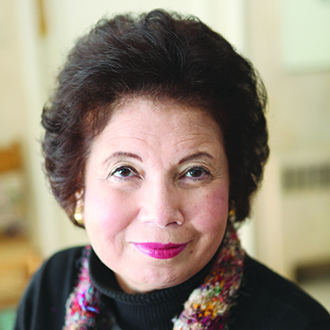Landscape painter Joy Moser has learned much about art from visiting other places.
“During my travels, (husband) Marvin and I had taken hundreds of photographs, which became the inspiration for my paintings,” she says.
Her series “European Trees,” for example, evolved from her interest in the carefully constructed manmade landscapes of Europe.
“Nature is tamed in a particular way,” she says. “You don’t find trees planted this way in America.”
Buoyant, outgoing and physically fit at the age of 80, Moser has plenty of creative fuel left in her tanks. Her physician husband, in his mid-80s, is one of the nation’s foremost experts on hypertension and teaches at Yale University in New Haven. The art educator-turned-painter credits him with the financial security that has enabled her to do what she believes in.
“It’s great to wake up in the morning and look forward with enthusiasm to what you are going to do that day.”
The Scarsdale resident has done much over the course of a long and fulfilling career, though ironically she had no interest in art at first.
“I attended Sarah Lawrence College, majoring in philosophy,” Moser, who comes from a small town in Pennsylvania, recalls. “I was then admitted to Columbia University law school. Instead of finishing my degree, I met and married Marvin and moved to the suburbs.”
The Mosers had their first child early on and Moser became acquainted with a Scarsdale neighbor who was a painter.
“She gave me some basic instruction and started me out in landscape painting, which I did in the attic on the third floor of our home. I made another friend who was a painter of abstracts and he helped me to get admitted into an art education program.”
Moser had two more children and continued to paint mostly abstract works in the attic of her Scarsdale home for several decades as her children grew. She acquired a teaching position in the art education program at New York University that morphed into a full professorship. She received her master’s degree in l963 and a doctorate in art education in l979.
By this time Moser had already taken her first painting courses, leading her to explore geometric abstraction. She had also become intrigued with the art of children.
Although this was a very busy period in her life, Moser decided to help found the Storefront Studio, a children’s art program in downtown White Plains.
“At this point in time, White Plains was undergoing urban renewal and there were plenty of empty buildings and storefronts,” she says. “Our group wanted to have something life-affirming in the midst of the urban-renewal chaos. We started small and the Storefront Studio eventually became a large program that ran for four years out of a storefront right on the street. This was a very happy time in my life.”
As urban renewal advanced through White Plains, the Storefront Studio moved along with it. But by 1972 usable buildings had disappeared.
“The Storefront Studio was offered space in a housing project, but we turned it down,” Moser says. “There were too many rules. I realized the time had come for it to end.”
But the Storefront Studio had sealed Moser’s reputation in art education.
“Our program used rich original resources, not watering things down and used culture in an authentic way,” she says. “The children thrived.”
In the mid-1980s, Moser went on to teach at The Metropolitan Museum of Art, becoming increasingly intrigued with 17th- and 18-century Dutch and English landscape painting. Her new fascination with landscape began to influence her own painting, which she continued to produce in her attic studio. By 1987, teaching full time had lost its appeal for a number of reasons, including departmental politics.
With the children well on their way to independent lives – daughter Jill was now an artist herself; son John, an actor; and son Stephen, an architect – Moser took a sabbatical and devoted it to landscape painting. Since redirecting her artistic vision, she has had many exhibits and seen her works hung in many prestigious institutions, including the Hudson River Museum in Yonkers, the Greenwich Library and the Whitney Museum of American Art and Columbia University’s Macy Gallery, both in Manhattan.
Moser now paints regularly in an airy, light-filled studio added on the back of the family home’s garage. With soaring ceilings and ample space for storage of art supplies and finished canvases, the neatly-kept studio is a haven.
But she still keeps a hand in teaching as an adjunct professor.
“In 1992 Teachers College of Columbia University asked me to join the faculty, and I have been there ever since,” she says. “I teach art theory and the contemporary art world. I also teach a studio class. I went to teach for one semester and I am still there.”
Looking back over her career in the fine arts, Moser says it’s been a matter of progression.
“I began in the late 1950s when abstraction was ‘the only game in town,’” she says. “I followed along and progressed through many styles, finally ending with biometric and nonobjective painting.”
“The radical move for me was to discover that the real world of landscape lurked behind all that past work. My childhood in the mountains of Pennsylvania pervaded my way of seeing and I wanted to investigate and celebrate the infinite variety of tone, color and composition that I found around me.”
Moser says sky, the structure of trees, mist and water appeared to fill a hunger in her to look again and again.
“There was mystery and danger lurking behind the beauty and my aim was to try to avoid the cliché and explore the infinite structure of the visual landscape.”
For more, visit joymoserstudio.com.

